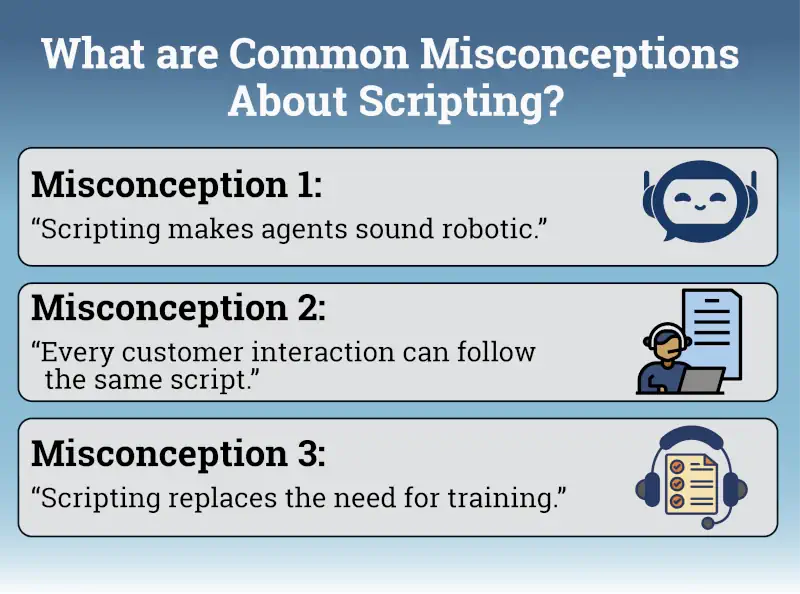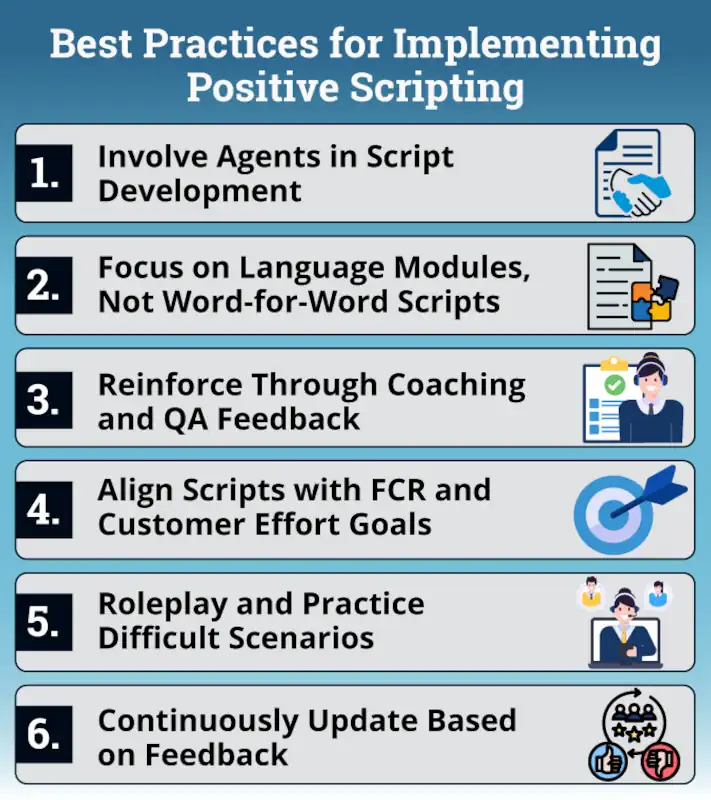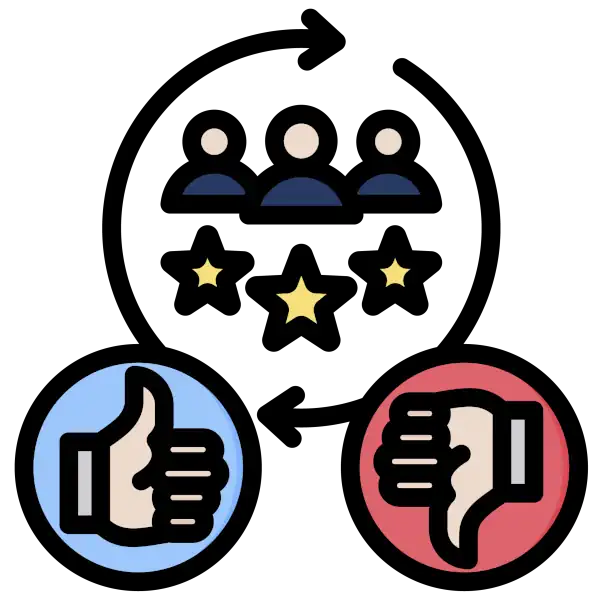Every customer interaction is an opportunity to build trust - or break it. Tone, empathy, and clarity are just as important as resolving the issue itself. That’s where positive scripting comes in.
Positive scripting is a technique used by contact centers to guide agents in delivering more customer-friendly conversations. Rather than relying on rigid scripts, it equips agents with language frameworks and emotionally intelligent phrasing to create a more personalized and solution-focused experience.
At SQM Group, we know that achieving high First Call Resolution (FCR) rates requires more than just solving problems; it’s also about how customers feel during and after the call. Positive scripting supports this by reducing confusion, softening difficult messages, and reinforcing a sense of care and professionalism.
In this blog, we’ll explore what positive scripting is (and what it isn’t), its benefits, common pitfalls, real-world examples, and how to implement it in a way that supports both customers and agents.
What is Positive Scripting?
Positive scripting is a strategic approach to customer service communication that emphasizes helpful, empathetic, and solution-oriented language. It provides agents with suggested phrases and conversational structures that help de-escalate tension, clarify next steps, and maintain a positive tone - especially in complex or emotionally charged interactions.
Unlike traditional rigid scripting, positive scripting does not aim to control the entire dialogue. Instead, it offers guidelines and phrasing options that agents can adapt to fit each unique interaction. It’s not about reciting a script word-for-word, but about choosing language that aligns with the company’s values and creating a better experience for the customer.
For example, instead of saying, “That’s not our policy,” a positively scripted alternative would be, “Here’s what I can do for you today.” This reframes the message in a way that focuses on action and support rather than limitation.

When done well, positive scripting can support call quality and help agents feel more confident - especially in high-pressure moments. It’s an important part of a customer experience strategy that values emotional intelligence just as much as problem-solving.
Why Does Language Matter in Customer Service?
In customer service, what you say matters, but studies show how you say it matters even more. The language agents use during a call directly shapes how customers perceive the interaction, the company, and whether or not their issue was truly resolved. Even when a problem is solved, a negative tone or poorly chosen words can leave customers feeling dissatisfied or dismissed.
Positive language helps reframe challenges into opportunities for support. For example, instead of saying “You’ll have to wait 3–5 business days,” saying “Your request will be completed within 3–5 business days, and I’ll make sure to keep you updated along the way” sets a more proactive and reassuring tone. It’s the same message—just framed with care and clarity.

This matters because customer service interactions are emotionally charged by nature. People are often calling because something has gone wrong. The agent’s job, then, is not just to fix the issue—it’s to guide the customer through it in a way that builds confidence and trust. Language is a powerful tool for doing exactly that.
Research also shows that positive communication reduces perceived effort, a key factor in FCR and CSAT. When agents communicate clearly and confidently using empathetic language, customers are less likely to call back, escalate the issue, or leave frustrated.
At SQM Group, we’ve seen firsthand how tone and word choice influence FCR performance and call quality ratings. Customers don’t just remember whether they got their problem solved—they remember how it felt to be helped. Positive scripting helps make those memories better.
What are Some Common Misconceptions About Scripting?
Despite its benefits, positive scripting is often misunderstood—especially in contact center environments where authenticity and personalization are highly valued. Let’s clear up a few of the most common misconceptions:
Misconception 1: “Scripting makes agents sound robotic.”
This can be true with traditional word-for-word scripts. However, positive scripting isn’t about memorization—it’s about providing adaptable language tools. When agents are trained to personalize phrasing while maintaining a positive tone, the result is a natural, confident conversation, not a robotic one.
Misconception 2: “Every customer interaction can follow the same script.”
A rigid, one-size-fits-all script can actually hurt the customer experience. Positive scripting should be contextual - agents need room to adjust based on the customer’s tone, emotion, and needs. Effective scripts are modular, offering phrases and transitions that support real-time judgment and adaptability.
Misconception 3: “Scripting replaces the need for training.”
Scripts are tools—not solutions in themselves. They work best when combined with soft skills training, product knowledge, and emotional intelligence. Agents must still actively listen, respond with empathy, and know when to deviate from a script to truly resolve the issue.

Positive Scripting Examples (With Before & After)
To truly understand the power of positive scripting, it helps to see it in action. Below are common call center phrases that can unintentionally frustrate or confuse customers—followed by more effective, positively framed alternatives.
| Negative or Flat Language | Positive Scripting Alternative | Why it Works |
|---|---|---|
| "That's not my department." | "Let me connect you with the right person who can help." | Keeps the focus on resolution rather than deflection. |
| "I don't know." | "That's a great question—let me find out for you." | Reframes uncertainty as proactive problem-solving. |
| "You need to..." | "What you can do is..." or "The next best step is..." | Sounds more collaborative and less commanding. |
| "Calm down." | "I understand this is frustrating—let’s work through it together." | Validates emotion and builds trust. |
| "There's nothing I can do." | "Here’s what I can do to help right now." | Focuses on available solutions rather than limitations. |
| "That’s our policy." | "Here’s how we usually handle this—and I’ll do my best to support you." | Acknowledges structure without sounding inflexible. |
| "You’ll have to wait." | "This will be ready within 3–5 business days, and I’ll make sure to keep you updated." | Reframes delay with a clear timeline and reassurance. |
Positive scripting isn’t about sugarcoating problems—it’s about clarity, care, and confidence. These small shifts in phrasing can lead to significant improvements in how customers feel about the interaction.
When Positive Scripting Helps—and When It Hurts
Like any tool, positive scripting works best when used in the right context. When applied thoughtfully, it enhances communication, reduces customer effort, and builds trust. But if used without sensitivity or flexibility, it can have the opposite effect.
When Positive Scripting Helps:
- Emotionally charged interactions: In stressful or sensitive situations, supportive and empathetic language can de-escalate tension and make customers feel heard.
- Complex or repetitive calls: Scripts help agents stay on track and communicate complex information clearly, reducing confusion.
- Training new agents: Positive scripting gives new agents confidence by offering tested language patterns they can use while learning.
When It Can Hurt:
- Overused or insincere language: Repeating scripted apologies or phrases without genuine tone can sound robotic or dismissive (e.g., “I’m sorry you feel that way”).
- Avoiding accountability: If scripting is used to dodge responsibility or deliver “non-answers,” it damages credibility.
- Ignoring emotional cues: Sticking too closely to a script can cause agents to miss the customer’s real issue or emotional state.
First Call Resolution depends not just on the agent’s words, but their ability to actively listen, empathize, and adapt. Positive scripting should serve as a guide—not a barrier—to human connection. When combined with good judgment and emotional intelligence, it supports high-quality, low-effort calls that get resolved the first time.
Best Practices for Implementing Positive Scripting
Successful implementation of positive scripting requires more than writing a list of nice-sounding phrases. It’s a collaborative, iterative process that should involve agents, coaches, QA teams, and leadership—and align with broader goals like FCR, CSAT, and employee engagement.

Here are some best practices to consider:

1. Involve Agents in Script Development
Agents are the ones having the conversations—so their insights are invaluable. Co-creating scripts with frontline staff helps ensure the language is natural, authentic, and grounded in real-world scenarios.

2. Focus on Language Modules, Not Word-for-Word Scripts
Provide flexible frameworks: transition phrases, empathy statements, and solution-oriented options that agents can tailor. Avoid locking them into rigid dialogues.

3. Reinforce Through Coaching and QA Feedback
Use QA scorecards and call reviews to identify opportunities for scripting improvement. Positive scripting should be part of performance coaching, not a separate checklist item.

4. Align Scripts with FCR and Customer Effort Goals
The goal isn’t just to sound friendly—it’s to resolve the issue. Ensure that scripts help reduce friction, clarify next steps, and empower agents to get things done efficiently.

5. Roleplay and Practice Difficult Scenarios
Training sessions should include examples of emotionally charged or complex calls, and how to apply positive language effectively in those moments. Practicing these skills builds agent confidence and adaptability.

6. Continuously Update Based on Feedback
Review customer feedback, QA trends, and agent suggestions regularly. Scripts should evolve alongside products, customer expectations, and service channels.
By following these best practices, contact centers can build a scripting strategy that empowers agents, improves the customer experience, and directly supports measurable improvements in FCR and call quality—a core focus of SQM Group’s performance model.
